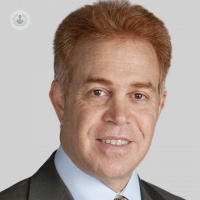Deviated septum: when it needs treatment
Written by:A deviated septum is where the middle part of your nose – which divides your nostrils – is slightly to one side. Up to 60-70% of us could be affected by nasal septum deviation – so when does it need treatment? We spoke to leading London-based ENT surgeon, Mr Abbad Toma:

Is a deviated septum always a problem?
Nasal septum deviation is a very common finding. It is estimated that 60-70% of adults have some deviation of the nasal septum. This could either have happened at childbirth or due to trauma.
There are four situations where a deviated septum becomes a problem:
- It causes significant subjective airway obstruction interfering with normal quality of life or difficulty sleeping.
- In patients needing to use a nasal spray, the severity of the nasal septum deviation can prevent adequate access to nasal medications.
- If a patient requires sinus surgery, the severity of the septal deviation can prevent access to the sinuses and therefore needs correction as part of the sinus procedure.
- If the deviation is severe or in a critical position, it may need to be corrected as part of a rhinoplasty procedure (nose reshaping).
How can a deviated septum be corrected? Is septoplasty the only option?
The only way to correct a nasal septum is a septoplasty. This can be a relatively uncomplicated procedure performed through the nose with no external scars, but in some patients the surgery can be very challenging. This is especially the case if it involves the external nose which will require an open approach in a procedure commonly known as an open septorhinoplasty.
Some patients may find temporary relief by using over-the-counter devices such as nasal strips or a nose cone.
Is septoplasty painful?
Pain is not a major feature of a septoplasty. Most patients leave hospital on the same day (day case surgery) and use simple analgesia for a few days only.
The main post surgery complaint is severe nasal obstruction for the first week, after which the swelling starts to settle. If the patient experiences increasing pain after a few days, this can be a sign of infection – which, although rare, must be treated urgently.
How much does a septoplasty cost?
The septoplasty procedure is covered by most insurance companies. However if it is complicated by the need for an open approach, this may not be covered by your insurance and will need to be discussed with your surgeon.
For uninsured (self-pay) patients, most hospitals have a fixed rate package to cover the cost of the surgery and hospital stay.
How do I decide on my septoplasty surgeon?
The surgery is usually performed by an ENT (ear, nose and throat) surgeon and preferably one with a special interest in rhinology (nose specialist). Septoplasty is often considered a routine procedure, but initial assessment is always key. This is because the initial assessment involves deciding whether the operation can be performed through the nose or via an open approach in order to avoid any complications and the need for further surgery.


